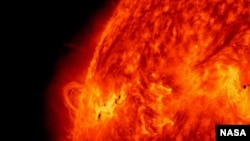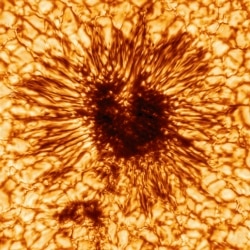SpaceX recently announced that a solar storm has disabled at least 40 of the 49 communication satellites that it recently launched.
The company said the satellites were launched on February 3 from the Kennedy Space Center in Florida. Around the same time, there was a “geomagnetic storm watch” listed by the U.S. Space Weather Prediction Center. The center warned that a large burst of solar plasma gas and electromagnetic radiation from the sun's surface would likely reach Earth’s atmosphere.
SpaceX said the storm greatly increased atmospheric density around the satellites’ low orbit. This created friction that disabled at least 40 of them.
Jonathan McDowell is a Harvard-Smithsonian astrophysicist. He said that the incident is believed to be the largest collective loss of satellites from a single geomagnetic event.
The threat of solar storms
Scientists are warning that these destructive solar storms could affect life on Earth at any time. These outbursts from the sun, which eject energy in the form of magnetic fields and plasma gas are unpredictable and difficult to prepare for.
Research shows that Earth is hit by a very destructive solar storm every century or two. In the past, these were mainly colorful light shows on the sky with limited effects on humanity. Modern technology, however, can be severely affected by these solar storms.
When an intense geomagnetic storm hit the Earth in September 1859, telegraph systems across North America and Europe failed. Some operators reported receiving electrical shocks. A solar storm in March 1989 caused power failures in Quebec, Canada.
The Halloween Storms of 2003 affected more than half of the orbiting satellites and disrupted aviation. Electrical service was also knocked out in parts of Europe for several hours, and transformers in South Africa were destroyed.
Raimund Muscheler is a geology professor at Lund University in Sweden. In a new study of ice samples, he concluded that a previously unknown, huge solar storm about 9,200 years ago would have destroyed communication systems if it had hit Earth in modern times.
Daniel Baker is an expert in planetary and space physics from the University of Colorado. When talking about solar storms, he said, “… it's something that really needs to be dealt with by policymakers." He added that “… in the longer term, it's not a question of if but when."
Possible damage
The sun outbursts could first disrupt the ionosphere — where the Earth's atmosphere meets space — and radio communications. They also create additional friction on some satellites, which is what happened to SpaceX satellites. The storm with its highly charged particles could also be radioactive and presented a danger to astronauts in orbit.
The gas and magnetic field explosions on the surface of the sun, known as “coronal mass ejection,” could overload Earth’s electrical power systems and speed corrosion of pipelines.
"The geomagnetic storm can actually cause transformers to burn through if they are not adequately protected," said Muscheler of Lund University.
Sangeetha Abdu Jyothi is an assistant professor in the computer sciences at the University of California, Irvine. She warned that solar storms could also damage long-distance communication lines between North America and Europe.
Any major solar storm could threaten Global Positioning System (or GPS) satellites which are critical to modern life from driving cars to flying planes. And a big storm can cause a reduction in the ozone to affect the climate on Earth.
Solar cycles
McDowell of Harvard-Smithsonian expects geomagnetic storm activity to increase as the sun nears its 11-year cycle of magnetic field activity known as sunspots.
The cycle is predicted to be at its worst in July 2025. Solar scientists say the good news is that it will be less intense than the most active cycles of past centuries. However, some governments seem unprepared for possible damage likely to be caused by future major storms.
Baker, the University of Colorado expert said a concerned woman in France contacted officials there for advice on how to prepare for a major geomagnetic storm.
They told her, "We suggest you buy a chocolate cake, eat it and wait for the end of the world.”
I’m Jill Robbins. And I’m Dan Friedell.
Steve Herman reported this story for VOA News. Gregory Stachel adapted the story for VOA Learning English with additional reporting from Reuters.
________________________________________________________________
Words in This Story
geomagnetic – n. the magnetism of the earth
astrophysics – n. the scientific study of the physical and chemical properties and structures of stars, planets, and other objects in outer space
friction – n. the force that causes a moving object to slow down when it is touching another object
aviation – n. the business or practice of flying airplanes or helicopters
sample – n. a small amount of something that gives you information about the thing it was taken from
corrode – v. to gradually destroy or weaken (something)
adequately – adj. enough for some need or requirement
cycle – n. a set of events or actions that happen again and again in the same order: a repeating series of events or actions
We want to hear from you. Write to us in the Comments section, and visit our Facebook page.











